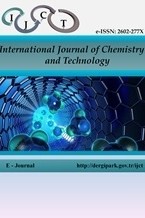A corrosion study: Use of Thionine dye having structurally metachromatic influence
A corrosion study: Use of Thionine dye having structurally metachromatic influence
Thionine, adsorption, acidic corrosion FESEM,
___
- 1.https://nptel.ac.in/courses/113106032/16%20-%20Properties%20and%20Applications%20of%20Materials.pdf (Retrieved December 17, 2018).
- 2. Vitos, L.; Zhang, H.L.; Lu, S.; Al-Zoubi, N.; Johansson, B.; Nurmi, E.; Ropo, M.; Punkkinen, M.P.J.; Kokko, K. Alloy Steel: Properties and Use First-Principles Quantum Mechanical Approach to Stainless Steel Alloys. In. Morales E.V. (Eds). Croatia, Intech Open Access Publisher, 2011, Chap 1.
- 3. The Balance, Steel Grades and Properties. What Are the Different Types of Steel? Adres: https://www.thebalance.com/steel-grades-2340174 (Retrieved December 17, 2018).
- 4. El-raouf, M.A.; El-Azabawy, O.E.; El-Azabawy, R.E. Egypt. J. Pet. 2015, 24, 233–239.
- 5. Gong, W.; Yin, X.; Liu, Y.; Chen, Y.; Yang, W. Prog.Org. Coat. 2019, 126, 150–161.
- 6. Asaad, M.A.; Ismail, M.; Tahir, M.Md.; Huseien, G.F.; Raja, P.B.; Asmara, Y.P. Constr. Build. Mater. 2018, 188, 555–568.
- 7. Al-Amierya, A.A.; Ahmed, M.H.O.; Abdullah, T.A.; Gaaz, T.S.; Kadhum, A.A.H. Results Phys. 2018, 9, 978–981.
- 8. Javadian, S.; Darbasizadeh, B.; Yousefi, A.; Ektefa, F.; Dalir Jamal Kakemam, N. J. Taiwan Ins. Chem. Engin. 2017, 71, 344–354.
- 9. Palanisamy, K.; Kannan, P.; Sekar, A. Surf. Interfaces, 2018, 12, 50–60.
- 10. Madkour, L.H.; Kaya, S.; Kaya, C.; Guo, L. J. Taiwan Inst. Chem. E. 2016, 68, 461–480.
- 11. Pareek, S.; Jain, D.; Hussain, S.; Biswas, A.; Shrivastava, R.; Parida, S.K.; Kisan, H.K.; Lgaz, H.; Chung, Ill-Min,; Behera, D. Chem. Eng. J. 2019, 358, 725–742.
- 12. Madkour, L.H.; Kaya, S.; Guo, L.; Kaya, C. J. Mol. Struct. 2018, 1163, 397–417.
- 13. El Nemr, A.; Moneer, A.A.; Khaled, A.; El Sikaily, A.; El-Said, G.F. Mater. Chem. Phys. 2014, 144, 139–154.
- 14. Singh, A.; Lin, Y.; Liu, W.; Yu, S.; Pan, J.; Ren, C.; Kuanhai, D. J. Ind. Eng. Chem. 2014, 20, 4276–4285.
- 15. Chen, B.Y.; Xu, B.; Yueh, P.L.; Han, K.; Qin, L.J.; Hsueh, C.C. J. Taiwan Ins. Chem. Engin. 2015, 51, 63–70.
- 16. Ho, P.I.; Kumar, G.G.; Kim, A.R.; Kim, P.; Nahm, K.S. Bioelectrochemistry, 2011, 80, 99–104.
- 17. Ackroyd, W. Chem. News 1876, 33, 60.
- 18. Ehrlich, P.; Arch. Anat. Physiol. 1879, 36, 166–169.
- 19. Pradeep D’mello, A.X.; Sylvester, T.V.; Ramya, V.; Britto, F.P.; Shetty, P.K.; Jasphin, S. Int. J. Adv. Health Sci. 2016, 2-10, 12–17.
- 20. Khayyat, S.A.; Akhtar, M.S.; Umar, A.; Mater. Lett. 2012, 81, 239–241.
- 21. Rahimnejad, M.; Najafpour, G.D.; Ghoreyshi, A.A.; Shakeri, M.; Zare, H. Int. J. Hydrogen Energ. 2011, 36, 13335–13341.
- 22. Umoren, S.A.; AlAhmary, A.A.; Gasem, Z.M.; Solomon, M.M. Int. J. Biol. Macromol. 2018, 117, 1017–1028.
- 23. Tasić, Ž.Z.; Petrović Mihajlović, M.B.; Radovanović, M.B.; Simonović, A.T.; Antonijević, M.M. J. Mol. Struct. 2018, doi: 10.1016/j.molstruc.2018.01.031.
- 24. Solmaz, R. Corros. Sci. 2014, 79, 169–176.
- 25. Özkır, D.; Kayakırılmaz, K.; Bayol, E.; Gürten, A.A.; Kandemirli, F. Corros. Sci. 2012, 56, 143–152.
- 26. Chauhan, D.S.; Ansari, K.R.; Sorour, A.A.; Quraishi, M.A.; Lgaz, H.; Salghi, R. Int. J. Biol. Macromol. 2018, 107, 1747–1757.
- 27. Özkır, D. J. Electrochem. Sci. Technol. 2019, 10 (1), 37–54.
- 28. Özkır, D. OHU J. Eng. Sci. 2018, 7(2), 993–1003.
- 29. Wysocka, J.; Cieslik, M.; Krakowiak, S.; Ryl, J. Electrochim. Acta 2018, 289, 175–192.
- 30. Obot, I.B.; Obi-Egbedi, N.O.; Umoren, S.A. Corros. Sci. 2009, 51, 276–282.
- 31. Popova, A.; Sokolova, E.; Raicheva, S.; Christov, M. Corros. Sci. 2003, 45, 33–58.
- 32. Noor, E.A. and Al-Moubaraki, A.H. Mater. Chem. Phys. 2008, 110, 145–154.
- 33. Singh, D.K.; Ebenso, E.E.; Singh, M.K.; Behera, D.; Udayabhanu, G.; John, R.P. J. Mol. Liq. 2018, 250, 88–99.
- Yayın Aralığı: Yılda 2 Sayı
- Başlangıç: 2017
- Yayıncı: İbrahim DEMİRTAŞ
Sinem AYDIN, Cavidan DEMİR GÖKIŞIK
Optimization, isotherm and kinetics studies of azo dye adsorption on eggshell membrane
Ayşe DİNÇER, Mervecan SEVİLDİK, Tülin AYDEMİR
A study on leaching kinetics of chalcopyrite in KNO3 + H2SO4 medium
Harun DİKME, Soner KUŞLU, Özlem KARAGÖZ
Gül KOTAN, Bedrettin SAVAŞ, Haydar YÜKSEK
Stress behaviours of viscoelastic flow around square cylinder
Guler Bengusu TEZEL, Kerim YAPICI, Yusuf ULUDAG
A corrosion study: Use of Thionine dye having structurally metachromatic influence
Mehmet Salih AĞIRTAŞ, Cihan DURMUŞ, Beyza CABİR
Enhancing the adsorption of disinfection by-products onto activated carbon using TiO2 nanoparticles
Rapid isolation of rosmarinic acid from Ocimum basilicum using flash chromatography
